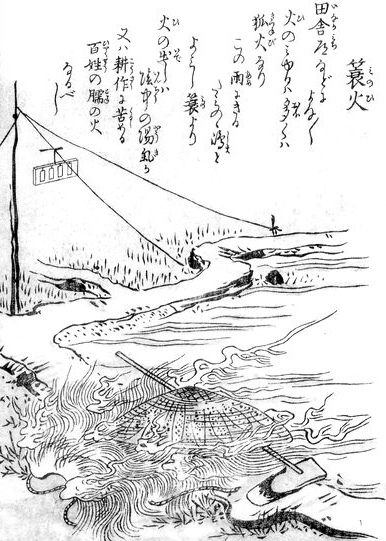Well, the Kickstarter blew up! In less than twenty four hours we passed 400% funding, and we are now approaching 500%! That’s much faster than my two previous Kickstarters. I think it goes to show that yokai are becoming more and more well known around the world, and that more and more people want to learn about and share this fantastic folklore!
Now, on to A-Yokai-A-Day!
Okikumushi
於菊虫
おきくむし

Toriyama Sekien’s Sarakazoe
Today’s yokai is an interesting one because of its relation to a yokai we looked at recently as part of my Patreon project. In August, we looked at the Three Big Ghost Stories of Japan. One of these, Okiku, is so famous that she spawned a number of other yokai. While Okiku has appeared on A-Yokai-A-Day before, the new painting of her will appear in The Book of the Hakutaku, along with the other ghosts we looked at in the Patreon project.
Toriyama Sekien included a yokai based on Okiku in his book Konjaku gazu zoku hyakki: the sarakazoe, or “dish counter.” Sarakazoe doesn’t really differ much from the original tale of Okiku, so it may have just been Sekien’s attempt at “classifying” the type of ghost that Okiku became when she died, rather than calling it an “Okiku ghost” or something like that.

Okikumushi from Ehon hyaku monogatari
The other famous yokai derived from Okiku is the okikumushi, or “okiku worm.” This yokai appeared in the Ehon hyaku monogatari, published in 1841.
Okikumushi is sort of a post scriptum to Okiku’s story. In most versions of her story, her ghost is laid to rest when a priest shouts, “TEN!” after she counts her ninth plate and before she can unleash her death scream.
In the story of okikumushi, it is said that after her death, her spirit came back as a type of bug, which could be seen crawling around the well where she drowned. Apparently this bug had features that resembled her, and were spawned by whatever part of her grudge remained on this world.
Interestingly, the okikumushi is a real insect. It’s a nickname for Byasa alcinous, or the Chinese windmill. Apparently in the late 18th century this nickname caught on. The chrysalis of this insect was thought to look like a tied up woman’s body. Since legend has it that Okiku was tied up and thrown down the well of Himeji castle, and because these caterpillars were seen in large numbers around the castle’s well, the name stuck. For many years, these bugs were even sold as souvenirs to tourists at shrines near the castle!
Although it’s a bit of a weird tale, it’s not unprecedented. The idea of the souls of the dead having an effect on the shape of living animals was already well circulated. A famous species of crab—the Heikegani—was named for its shell which resembles like a scowling samurai’s helmet. Legend was that the spirits of the slain Heike soldiers turned into these crabs, giving them their remarkable appearance.
No doubt whoever came up with the idea of okikumushi was well aware of her tale’s popularity. Maybe he or she sought to cash in on that and came up with this unofficial sequel to her story. The tourists liked it so much that the name stuck, and okikumushi became an indelible part of yokai folklore!

Okikumushi – from The Book of the Hakutaku
If you liked this story, you’ll definitely want to join my Kickstarter! Not only can you get The Book of the Hakutaku in paperback, ebook, and hardcover collector’s editions, you can also get yokai postcards, bookmarks, and other awesome stretch goals. Don’t miss out!




 In addition, I will be launching my third Kickstarter project. This goal for this Kickstarter is to produce a new yokai encyclopedia, entitled The Book of the Hakutaku. It will be my third volume, after The Night Parade of One Hundred Demons and The Hour of Meeting Evil Spirits—but you don’t need to have read those books in order to enjoy it. Since it’s an encyclopedia, it’s totally enjoyable on its own as a stand alone book.
In addition, I will be launching my third Kickstarter project. This goal for this Kickstarter is to produce a new yokai encyclopedia, entitled The Book of the Hakutaku. It will be my third volume, after The Night Parade of One Hundred Demons and The Hour of Meeting Evil Spirits—but you don’t need to have read those books in order to enjoy it. Since it’s an encyclopedia, it’s totally enjoyable on its own as a stand alone book.


